The Age of Sinan
Architectural Culture in the Ottoman Empire
Format:Paperback
Publisher:Reaktion Books
Published:1st Jul '07
Currently unavailable, our supplier has not provided us a restock date

Mimar Koca Sinan (c. 1489-1588), the Great Architect Sinan, was appointed chief royal architect to the Ottoman court by Sultan Suleyman I in 1539. During his fifty-year career he designed and constructed hundreds of buildings including mosques, palaces, harems, chapels, tombs, schools, almshouses, madrassahs, caravanserais, granaries, fountains, aqueducts and hospitals. His distinctive architectural idiom also left its imprint over the terrains of a vast empire extending from the Danube to the Tigris, and he became the most celebrated of all Ottoman architects, particularly renowned for his influence on the cityscape of Istanbul.
Sinan's most influential buildings were his mosque complexes, where his inventive experimentation with light-filled centralized domes, often compared with parallel developments in Renaissance Italy, produced spaces in which the central dome appeared weightless and the interior surfaces bathed in light. In this monumental new study, Gulru Necipoglu argues that Sinan's rich variety of mosque designs sprang from a process of negotiation between the architect and his patrons, rather than from unrestrained formal experimentation as has been previously described. The author is the first to use published and unpublished primary sources to illuminate the cultural setting in which Sinan's monuments were produced, received and experienced.
The author describes how Sinan created a layered system of mosque types, reflecting social status and territorial rank, shaped by ideas of identity, memory and decorum. Seen from this perspective, Sinan's works, with their highly standardized pattern of forms, used in ingeniously varied combinations, acquire dimensions of meaning that have not been previously recognized.
Brushing aside skewed orientalist and nationalist readings which have coloured many previous studies of his work, the author, using original documentation, provides the most detailed written study ever, of not only Sinan's architecture, but also, arguably, of Ottoman culture, politics and society in the classical age . . . Necipoglu's book is a publishing landmark an astoundingly rich work that, as it boldly states on the back cover, is unlikely ever to be superseded. Without question, The Age of Sinan is one of the most remarkable architectural biographies ever written and the book Sinan's life and work richly deserves. * Prospect magazine *
The Age of Sinan, a close reading of historical archives and the architect's vivid autobiography, is the best, most interesting book on the subject . . . Necipoglu's culturally specific, contextual reading is rare. * Architects' Journalthis truly marvellous book, which brings together the skills of an architectural historian, linguist and archival researcher, represents a profound advance over and above all previous studies in the field. In its comprehensiveness, its insights, and its careful and close readings of both monuments and documents, Necipoglu's book provides an indispensable and much needed point of reference . . . a true tour de force, one that will instruct and inspire not only students, but also seasoned scholars in the field, serving as a model and as a challenge for many years to come. * Journal of Islamic Studies *
[Gülru Necipoglu] has compiled and reordered all the useful observations made previously she has re-examined the standard sources, viewing them critically but without obvious prejudice and she has added an immense amount of information gleaned from the buildings themselves, and from a wide range of narrative sources. The results can be enlightening. * Cornucopia magazine *
The effort that has gone into the research and compilation of this publication is remarkable . . . an essential text for anyone with a serious interest in architecture. * Architectural Review *
Besides opening new avenues in studies of Ottoman architecture, [The Age of Sinan] provides an enjoyable reading not only for Ottoman historians but also those who are interested in Ottoman culture and architecture in general. * Journal of the Faculty of Architecture, Middle Eastern Technical University *
Gülru Necipoglu. . . offers a major new interpretation of his architecture that places him in the context of his time. . . . The drawings in this book are of the highest quality . . . Indeed, this is one of the most comprehensively illustrated books on architecture that I have ever seen . . . [This is] an outstanding book * Henry Matthews, The Art Book *
truly comprehensive survey of the great builder's work under the patronage of several Ottoman sultans and their wealthiest subjects. The clear and elegantly written text is richly illustrated with hundreds of superb photos and architectural drawings documenting the architect's extraordinary achievement. The author's command of a vast array of both textual and visual sources is equally extraordinary. Necipoglu not only opens up whole new ways of appreciating prominent features of a major visual culture, she suggests innovative integrative categories for understanding the interplay of royal patronage, socio-political hierarchies, and religious symbolism. She has achieved a balanced and seamless melding of context and background. * John G. Renard, Religion and the Arts *
This book will stand the test of time, and much of it will not be superseded for several generations. It will not only form a new and more solid foundation for all later Sinan scholarship, but it will also shape the parameters of interpretation and discourse on classical Ottoman architecture. * Yasser Tabbaa, Art Bulletin *
An historical and sociological tour de force, this book is written with authority, skill, and grace. The scholarship is of the highest order. Necipoglu is simply the most technically accomplished, historically minded, and most important historian of Islamic art working today. This book will become the definitive study of Sinan and of his age in cultural production * Cornell H. Fleischer, University of Chicago, author of Bureaucrat and Intellectual in the Ottoman Empire: The Historian Mustafa Ali (1541-1600) *
ISBN: 9781861892539
Dimensions: unknown
Weight: unknown
592 pages